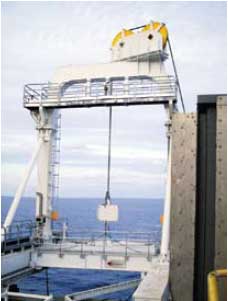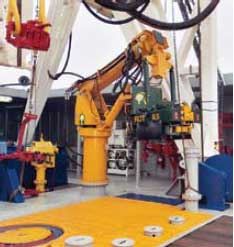Increased global drilling activities have led to a surge in new vessel construction. This has fostered an emphasis on increased efficiency and flat time reduction, especially in the newbuild sector where more activities are being performed offline.
Designed by ODS International, Inc., the Offline Tree Deployment System (OTDS) provides a dedicated means of running subsea trees, which is completely independent of all well center activities. This deployment system significantly reduces the tree-running times, Fig. 1.
 |
|
Fig. 1. The Offline Tree Deployment System increases efficiency by reducing tree-running times.
|
|
The system is based on a robust set of cantilever beams and A-frame, which enable the OTDS to be scaled to meet any tree-handling needs. The beams contain skid rails built onto their inside faces to accommodate a hydraulically driven tree skid. These beams carry a Christmas tree, stored offline, to a position below the electrical winch system, mounted on top of the A-frame. The winch lifts the tree off the base, allowing the tree skid to return to its offline position. The winch can then lower the tree over the vessel edge and into the sea.
The system is produced to a very high specification for frequent use in harsh and demanding environments. Equipment maintenance requirements are minimal to reduce downtime.
Each system can be tailored to specific weight and deployment depth requirements and is nominally rated for a 70-metric ton tree package. The system can be further customized by adding optional A-frame stabilizers, an active heave-compensation system or a customized mounting structure.
In addition to the OTDS, ODS International’s Roger’s Oil Tools has introduced a new drill pipe tong, Fig. 2. This self-contained tong operates with minimal movement, reducing accident risk. While the tong is highly durable, its grip exerts less stress on pipe, minimizing tool joint damage.
 |
|
Fig. 2. The Rogers Drill Pipe Tong provides uniform makeup.
|
|
The Rogers Drill Pipe Tong can provide uniform makeup on 4¼-in. up to 10-in. drill pipe. Torque can be controlled by limiting the maximum hydraulic pressure or by releasing the throttle when the recommended torque registers on the torque gauge. The new tong eliminates uncontrolled cathead pull and misleading torque readings.
The tong maximizes the life of rotary shouldered connections with uniform makeup and controlled torque. Its unitized design contains all torque within the tool joints, preventing the pipe from turning in the slips or bending between the tool joint and rotary table.
The new tool combines the lead tong, backup tong and spinning chain into one power tool. This three-in-one design results in less wall damage and increased tripping speed without rotating the drillstring. Laying down pipe becomes an efficient operation with over 200,000 ft-lbs of torque available to break any connection.
Additional safety features include: “deadman” controls, a tong door equipped with a system “lockout” to prevent operation with the door open and an available remote auxiliary operating system.
The tong is available in four models and generates torque from 65,000 ft-lb to over 200,000 ft-lb. Three available mounting options include a compact derrick-mounted device, a free-standing positioning system with a hydraulically powered, box-boom positioner and a custom-fit positioning system, which includes a hydraulically powered, three-stage positioner. Additional options include a mud diverter system and an adjustable pipe-centering cover. 
|




